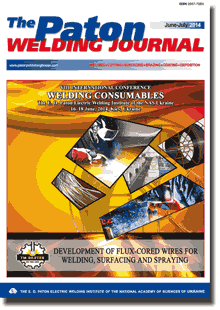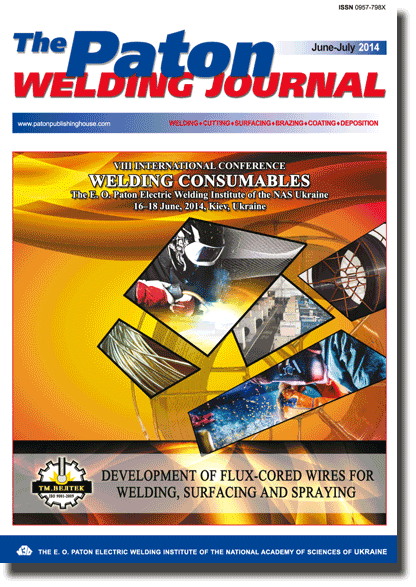| 2014 №06 (36) |
DOI of Article 10.15407/tpwj2014.06.37 |
2014 №06 (38) |

The Paton Welding Journal, 2014, #6-7, 172-176 pages
IMPROVEMENT OF ADAPTABILITY TO FABRICATION AND WELDING PROPERTIES OF ELECTRODES FOR TIN BRONZE WELDING AND SURFACING
T.B. MAJDANCHUK and N.V. SKORINA
E.O. Paton Electric Welding Institute, NASU. 11 Bozhenko Str., 03680, Kiev, Ukraine. E-mail: office@paton.kiev.ua
Abstract
The paper gives the results of investigation of the influence of various kinds of alkali-silicate binder on adaptability to fabrication and welding properties of coated electrodes for tin bronze welding and surfacing. Both standard (sodium, potassium and mixed) and test lithium-containing liquid glasses were used during investigations. A procedure developed at PWI was used to determine plastic properties of electrode coating mixture and to assess the strength and hygroscopicity of electrode coatings. Studies of welding-technological and sanitary-hygienic properties of test electrodes were also performed. This resulted in selection of optimum kind of liquid glass, the most suitable for manufacture of coated electrodes for tin bronze welding and surfacing. 8 Ref., 4 Tables, 5 Figures.
Keywords: tin bronze, surfacing, coated electrodes, liquid glass, adaptability to fabrication
Received: 15.04.14
Published: 28.09.14
References
1. Ilyushenko, V.M., Anoshin, V.A., Skorina, V.N. et al. (2013) Choice of slag-forming base of electrode coating for arc welding and surfacing of cast tin bronzes. In: Proc. of 7th Sci.-Techn. Conf. of Junior Scientists and Specialists (Kiev, 22-24 May 2013).
2. Ilyushenko, V.M., Anoshin, V.A., Bondarenko, A.N. et al. (2013) Development of electrode materials for welding and surfacing of complex-alloyed bronzes. In: Abstr. of Int. Conf. on Welding and Related Technologies: Present and Future (Kiev, 25-26 Nov. 2013), 72-73.
3. Skorina, N.V., Kisilyov, M.O., Paltsevich, A.P. et al. (2011) Properties of lithium-containing liquid glasses for manufacture of welding electrodes. In: Proc. of 4th Int. Conf. on Welding Consumables of CIS Countries (Krasnodar, 2011), 75-82.
4. Marchenko, A.E., Gnatenko, M.F., Chalykov, A.I. et al. (1983) Comparative evaluation of technological properties of electrode coating mixtures Rouen, Vitosha and YONI/13 made with capillary and conic plastometers: SMEA Inform. Doc., Issue 1/23, 69-74. Kiev: Naukova Dumka.
5. Sokolov, V.A., Sotchenko, V.P., Marchenko, A.E. et al. (1981) Autoplastometer. Kiev: PWI.
6. Marchenko, A.E., Shkurko, S.A. (1975) Examination of electrode mixtures by capillary plastometer method. Svarochn. Proizvodstvo, 5, 11-13.
7. RD 03-613-03: Procedure for application of welding consumables in manufacture, mounting, repair and reconstruction of technical devices for hazardous industrial facilities. Introd. 19.06.2003.
8. Ershov, A.V., Ershov, A.A. (2013) Welding-technological properties of electrodes used for welding of building metal structures. Svarka i Diagnostika, 3, 56-60.
Suggested Citation
T.B. MAJDANCHUK and N.V. SKORINA (2014) IMPROVEMENT OF ADAPTABILITY TO FABRICATION AND WELDING PROPERTIES OF ELECTRODES FOR TIN BRONZE WELDING AND SURFACING. The Paton Welding J., 06, 172-176.The cost of subscription/purchase order journals or individual articles
| Journal/Currency | Annual Set | 1 issue printed |
1 issue |
one article |
| TPWJ/USD | 384 $ | 32 $ | 26 $ | 13 $ |
| TPWJ/EUR | 348 € | 29 € | 24 € | 12 € |
| TPWJ/UAH | 7200 UAH | 600 UAH | 600 UAH | 280 UAH |
| AS/UAH | 1800 UAH | 300 UAH | 300 UAH | 150 UAH |
| AS/USD | 192 $ | 32 $ | 26 $ | 13 $ |
| AS/EUR | 180 € | 30 € | 25 € | 12 € |
| SEM/UAH | 1200 UAH | 300 UAH | 300 UAH | 150 UAH |
| SEM/USD | 128 $ | 32 $ | 26 $ | 13 $ |
| SEM/EUR | 120 € | 30 € | 25 € | 12 € |
| TDNK/UAH | 1200 UAH | 300 UAH | 300 UAH | 150 UAH |
| TDNK/USD | 128 $ | 32 $ | 26 $ | 13 $ |
| TDNK/EUR | 120 € | 30 € | 25 € | 15 € |
AS = «Automatic Welding» - 6 issues per year;
TPWJ = «PATON WELDING JOURNAL» - 12 issues per year;
SEM = «Electrometallurgy Today» - 4 issues per year;
TDNK = «Technical Diagnostics and Non-Destructive Testing» - 4 issues per year.


